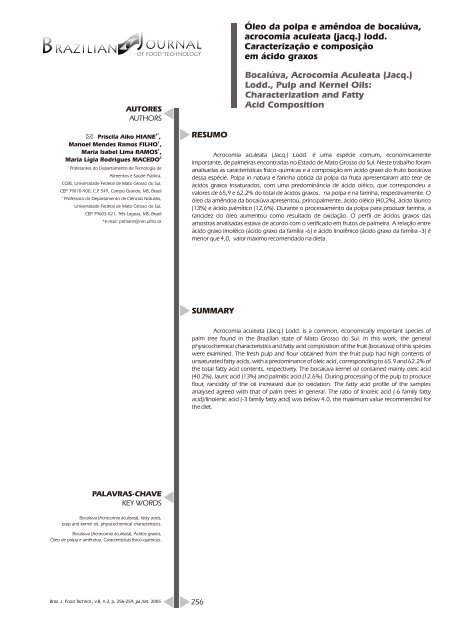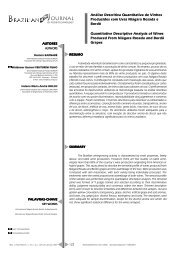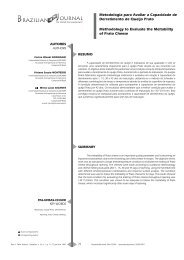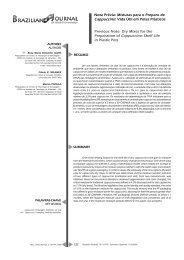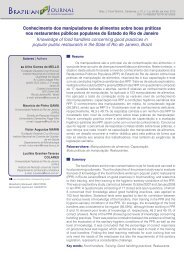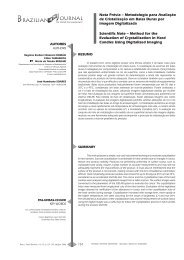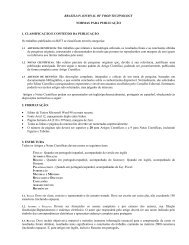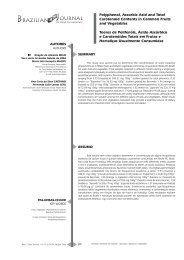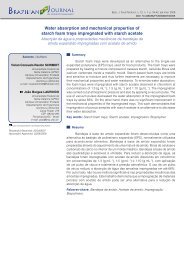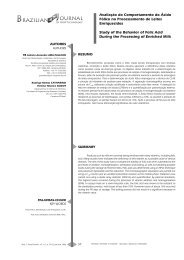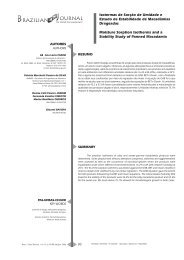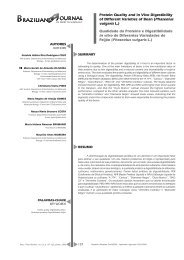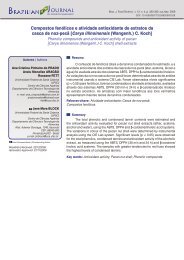Bocaiúva, Acrocomia Aculeata (Jacq.) - Brazilian Journal of Food ...
Bocaiúva, Acrocomia Aculeata (Jacq.) - Brazilian Journal of Food ...
Bocaiúva, Acrocomia Aculeata (Jacq.) - Brazilian Journal of Food ...
You also want an ePaper? Increase the reach of your titles
YUMPU automatically turns print PDFs into web optimized ePapers that Google loves.
OF FOOD TECHNOLOGY<br />
AUTORES<br />
AUTHORS<br />
Óleo da polpa e amêndoa de bocaiúva,<br />
acrocomia aculeata (jacq.) lodd.<br />
Caracterização e composição<br />
em ácido graxos<br />
Bocaiúva, <strong>Acrocomia</strong> <strong>Aculeata</strong> (<strong>Jacq</strong>.)<br />
Lodd., Pulp and Kernel Oils:<br />
Characterization and Fatty<br />
Acid Composition<br />
Priscila Aiko HIANE ,<br />
1<br />
Manoel Mendes Ramos FILHO ,<br />
1<br />
Maria Isabel Lima RAMOS ,<br />
2<br />
Maria Lígia Rodrigues MACEDO<br />
1<br />
Pr<strong>of</strong>essores do Departamento de Tecnologia de<br />
Alimentos e Saúde Pública,<br />
CCBS, Universidade Federal de Mato Grosso do Sul,<br />
CEP 79070-900, C.P. 549, Campo Grande, MS, Brazil<br />
2<br />
Pr<strong>of</strong>essora do Departamento de Ciências Naturais,<br />
Universidade Federal de Mato Grosso do Sul,<br />
CEP 79603-021, Três Lagoas, MS, Brazil<br />
*e-mail: prihiane@nin.ufms.br<br />
1*<br />
RESUMO<br />
<strong>Acrocomia</strong> aculeata (<strong>Jacq</strong>.) Lodd. é uma espécie comum, economicamente<br />
importante, de palmeiras encontradas no Estado de Mato Grosso do Sul. Neste trabalho foram<br />
analisadas as características físico-químicas e a composição em ácido graxo do fruto bocaiúva<br />
dessa espécie. Polpa in natura e farinha obtida da polpa da fruta apresentaram alto teor de<br />
ácidos graxos insaturados, com uma predominância de ácido oléico, que correspondeu a<br />
valores de 65,9 e 62,2% do total de ácidos graxos, na polpa e na farinha, respectivamente. O<br />
óleo da amêndoa da bocaiúva apresentou, principalmente, ácido oléico (40,2%), ácido láurico<br />
(13%) e ácido palmítico (12,6%). Durante o processamento da polpa para produzir farinha, a<br />
rancidez do óleo aumentou como resultado de oxidação. O perfil de ácidos graxos das<br />
amostras analisadas estava de acordo com o verificado em frutos de palmeira. A relação entre<br />
ácido graxo linoléico (ácido graxo da família -6) e ácido linolênico (ácido graxo da família -3) é<br />
menor que 4,0, valor máximo recomendado na dieta.<br />
SUMMARY<br />
<strong>Acrocomia</strong> aculeata (<strong>Jacq</strong>.) Lodd. is a common, economically important species <strong>of</strong><br />
palm tree found in the <strong>Brazilian</strong> state <strong>of</strong> Mato Grosso do Sul. In this work, the general<br />
physicochemical characteristics and fatty acid composition <strong>of</strong> the fruit (bocaiúva) <strong>of</strong> this species<br />
were examined. The fresh pulp and flour obtained from the fruit pulp had high contents <strong>of</strong><br />
unsaturated fatty acids, with a predominance <strong>of</strong> oleic acid, corresponding to 65.9 and 62.2% <strong>of</strong><br />
the total fatty acid contents, respectively. The bocaiúva kernel oil contained mainly oleic acid<br />
(40.2%), lauric acid (13%) and palmitic acid (12.6%). During processing <strong>of</strong> the pulp to produce<br />
flour, rancidity <strong>of</strong> the oil increased due to oxidation. The fatty acid pr<strong>of</strong>ile <strong>of</strong> the samples<br />
analysed agreed with that <strong>of</strong> palm trees in general. The ratio <strong>of</strong> linoleic acid (-6 family fatty<br />
acid)/linolenic acid (-3 family fatty acid) was below 4.0, the maximum value recommended for<br />
the diet.<br />
PALAVRAS-CHAVE<br />
KEY WORDS<br />
Bocaiúva (<strong>Acrocomia</strong> aculeata), fatty acids,<br />
pulp and kernel oil, physicochemical characteristics.<br />
Bocaiúva (<strong>Acrocomia</strong> aculeata), Ácidos graxos,<br />
Óleo de polpa e amêndoa, Características físico-químicas.<br />
Braz. J. <strong>Food</strong> Technol., v.8, n.3, p. 256-259, jul./set. 2005<br />
256
OF FOOD TECHNOLOGY<br />
HIANE, P. A.; RAMOS FILHO, M. M. ;<br />
RAMOS, M. I. L. & MACEDO, M. L. R.<br />
Óleo da polpa e amêndoa de bocaiúva,<br />
acrocomia aculeata (jacq.) lodd.<br />
Caracterização e composição<br />
em ácido graxos<br />
1. INTRODUCTION<br />
Bocaiúva is the popular name for fruit from the palm tree<br />
<strong>Acrocomia</strong> aculeata (<strong>Jacq</strong>.) Lodd., family Palmae which is<br />
abundant in the <strong>Brazilian</strong> state <strong>of</strong> Mato Grosso do Sul. Other<br />
species <strong>of</strong> this genus also occur in this state and also in southeastern<br />
Brazil and Central America, and they are known by<br />
common names such as macaúba, catarro coconut, macabira,<br />
mocajuba and macaíba (SILVA et al., 1994). Following<br />
maturation, the oily, semi-fibrous, mucilaginous pulp <strong>of</strong><br />
bocaiúva is edible and has a characteristic sweet flavour (POTT<br />
& POTT, 1994; ALMEIDA, 1998). The seed (kernel) <strong>of</strong> the fruit<br />
can be eaten raw or in the form <strong>of</strong> candies, known as "paçoca"<br />
and "cocada" (SILVA et al.,1994; ALMEIDA, 1998).<br />
The bocaiúva pulp contains yellowy red oil that can<br />
be used to produce cooking oil. The kernel also contains<br />
transparent oil that can be purified for use in cooking and the<br />
production <strong>of</strong> sweets (MACAÚBA, 1986). Oils and fats are<br />
important sources <strong>of</strong> energy for human metabolism. The effects<br />
<strong>of</strong> dietary lipids on growth and tissue fatty acid composition<br />
have been extensively investigated (SENANAYAKE & SHAHIDI,<br />
2002; LAPOSATA et al., 2002; PARK et al., 1999; STANTON et<br />
al., 1997). The involvement <strong>of</strong> saturated fatty acids in heart<br />
disease has led to the exclusion <strong>of</strong> fats from the diet (KEONG et<br />
al., 2003; GRISDALE-HELLAND et al., 2002). Flour prepared<br />
from the pulp <strong>of</strong> mature bocaiúva (<strong>Acrocomia</strong> mokayáyba Barb.<br />
Rodr.) has high vitamin A and oil contents (HIANE &<br />
PENTEADO, 1989; HIANE et al., 1990). This composition has<br />
led to interest in this fruit as a source <strong>of</strong> raw material for food<br />
products. It is possible that the good storage properties <strong>of</strong> the<br />
whole fruit with its hard peel, being more protected against<br />
photochemical reactions (FENNEMA, 1985), could allow for<br />
the flour to be produced out <strong>of</strong> season.<br />
AMAYA-FARFÁN et al. (1986) and HIANE et al. (1990),<br />
investigating other bocaiúva species, respectively <strong>Acrocomia</strong><br />
sclerocarpa Mart. and A. mokayáyba (Barb.) Rodr., from the<br />
<strong>Brazilian</strong> north-eastern and central west areas, showed that the<br />
oil <strong>of</strong> the fruit pulp contained principally oleic acid followed by<br />
palmitic acid; and in the oil <strong>of</strong> the kernel, AMAYA-FARFÁN et al.<br />
(1986) found lauric and oleic acids as the predominant fatty acids.<br />
In this work the general physicochemical<br />
characteristics and fatty acid composition <strong>of</strong> the fruit (bocaiúva)<br />
<strong>of</strong> the species <strong>Acrocomia</strong> aculeata (<strong>Jacq</strong>.) Lodd., from the<br />
<strong>Brazilian</strong> state <strong>of</strong> Mato Grosso do Sul, were examined, as well as<br />
verifying changes in the characteristics <strong>of</strong> the fruit pulp oil<br />
during processing to produce flour.<br />
2. METHODOLOGY<br />
[autor foi “pulp” ou “flour”].<br />
The oil in the fresh pulp, pulp flour and kernels was<br />
extracted by the Bligh & Dyer method, as described by KATES<br />
(1972), in order to determine its physicochemical properties<br />
and fatty acid composition.<br />
2.2. Methods<br />
2.2.1. Oil content<br />
The oil content was determined by direct extraction in<br />
a Soxhlet apparatus, using petroleum ether (boiling point 40-<br />
60oC), according to standard procedures (INSTITUTO ADOLFO<br />
LUTS, 1985).<br />
2.2.2. Physicochemical characteristics<br />
The physicochemical characteristics <strong>of</strong> the fresh pulp,<br />
pulp and kernel oils were determined by standard procedures<br />
recommended by THE INSTITUTO ADOLFO LUTZ (1985) and<br />
the AMERICAN OIL CHEMISTS' SOCIETY - AOCS (1998).<br />
For acidity, an aliquot <strong>of</strong> oil was weighed, dissolved in<br />
ethyl ether:ethanol (2:1, v/v) and titrated with 0.1mol/L sodium<br />
hydroxide. The iodine content was determined by the method<br />
<strong>of</strong> Wijs, using Wijs solution and 0.1mol/L sodium thiosulphate.<br />
The refractive indices <strong>of</strong> the pulp and kernel oils were<br />
determined in an Abbé refractometer. The saponification value<br />
was determined by saponification with 4% potassium<br />
hydroxide and titration with 0.5N HCl. The peroxide content <strong>of</strong><br />
the oil was determined according to the AOCS method.<br />
2.2.3. Fatty acid composition<br />
After extraction, the oils were saponified and the fatty<br />
acids converted to methyl esters as described by HARTMAN &<br />
LAGO (1973).<br />
The fatty acid methyl esters were analysed, using a<br />
model Star 3400 Varian Gas Chromatograph, equipped with a<br />
flame ionisation detector, a split/splitless injector and a capillary<br />
column <strong>of</strong> melted silica (30 m x 0.25 mm, J & Scientific, USA),<br />
containing polyethylene glycol (D B Wax) as the stationary<br />
phase. The chromatographic conditions used included:<br />
detector temperature <strong>of</strong> 260ºC, injector temperature <strong>of</strong> 250ºC,<br />
column temperature <strong>of</strong> 200ºC for 20 min, programmed for 1ºC<br />
per minute up to 220ºC, hydrogen gas with flow rates <strong>of</strong><br />
1.1mL/min., make-up gas <strong>of</strong> nitrogen for 22mL/min.<br />
The fatty acids were identified by comparing the<br />
retention times <strong>of</strong> the sample peaks with those <strong>of</strong> methyl ester<br />
standards <strong>of</strong> the fatty acids. The areas <strong>of</strong> the peaks were<br />
calculated and expressed as a percentage <strong>of</strong> the total area.<br />
2.1 Material<br />
Bocaiúva, <strong>Acrocomia</strong> aculeata (<strong>Jacq</strong>) Lodd., fruits<br />
were collected on the campus <strong>of</strong> the Federal University <strong>of</strong> Mato<br />
Grosso do Sul. For analysis, the fresh fruits (1kg) were shelled<br />
and the pulp and kernels removed and ground. A portion <strong>of</strong> the<br />
homogenized pulp was dehydrated in a forced ventilation oven<br />
at 40-50°C for 4h and then blended and sifted to obtain pulp<br />
3. RESULTS AND DISCUSSION<br />
3.1 Oil content and physicochemical characteristics<br />
Table 1 shows that the fresh pulp, flour and kernels <strong>of</strong><br />
bocaiúva were rich in oils with values <strong>of</strong> 16.5, 19.3 and 52.9%<br />
(on a wet basis), respectively.<br />
Braz. J. <strong>Food</strong> Technol., v.8, n.3, p. 256-259, jul./set. 2005<br />
257
OF FOOD TECHNOLOGY<br />
HIANE, P. A.; RAMOS FILHO, M. M.;<br />
RAMOS, M. I. L. & MACEDO, M. L. R.<br />
Óleo da polpa e amêndoa de bocaiúva,<br />
acrocomia aculeata (jacq.) lodd.<br />
Caracterização e composição<br />
em ácido graxos<br />
The acidity and peroxide content <strong>of</strong> the pulp flour<br />
were higher than those <strong>of</strong> the fresh pulp, indicating that the<br />
processing <strong>of</strong> bocaiúva pulp at 40 to 50°C to obtain flour led to<br />
the breakdown <strong>of</strong> glycerides with the release <strong>of</strong> free fatty acids<br />
and oxidation <strong>of</strong> the oil. Despite these higher values, the flavour<br />
<strong>of</strong> the product was unaltered, since fresh pulp contains lipolytic<br />
enzymes that hydrolyse the oil soon after maturation <strong>of</strong> the<br />
fruit, thereby releasing low molecular weight fatty acids and<br />
glycerol that give the fruit its characteristic flavour (MACAÚBA,<br />
1986; LAGO et al., 1991).<br />
Compared to oils from other palm tree fruits, the<br />
bocaiúva pulp and kernel oils showed lower acidity values than<br />
those found in buriti, palm and palmiste oils (TAVARES et al.,<br />
1990; SERRUYA et al., 1980); and these values were also low in<br />
comparison to the maximum allowable acidity for raw or virgin<br />
edible oils, such as olive and palm oils (maximum <strong>of</strong> 5.0%)<br />
(BRASIL, 1999).<br />
The saponification values agreed with those<br />
commonly found for the edible and refined oils (usual range:<br />
181-265) (BRASIL, 1999), and the iodine content was higher<br />
than reported for the pulp and kernel <strong>of</strong> palm oil (BRASIL, 1999;<br />
TAVARES et al., 1990).<br />
3.2 Fatty acid composition<br />
Table 2 shows the fatty acid compositions <strong>of</strong> bocaiúva<br />
pulp, pulp flour and kernel oil. In the pulp and pulp flour, there<br />
was a predominance <strong>of</strong> oleic acid, with levels similar to those<br />
found in the fruit <strong>of</strong> other palm trees (LAGO et al., 1991;<br />
SERRUYA et al., 1980; TRUJILLO-QUIJANO et al., 1992;<br />
AMAYA-FARFÁN et al., 1986; SOUZA et al., 1986; MESQUITA et<br />
al., 2001), palmitic acid being the second most abundant fatty<br />
acid, in agreement with previous reports (HIANE et al., 1990;<br />
AMAYA-FARFÁN et al., 1986). Oleic acid was the predominant<br />
fatty acid in the bocaiúva kernel, followed by lauric acid, whilst<br />
lauric acid was the predominant fatty acid in the kernel oil <strong>of</strong><br />
other previously reported bocaiúva species (AMAYA-FARFÁN et<br />
al., 1986).<br />
The fresh pulp and pulp flour showed similar contents<br />
<strong>of</strong> monounsaturated fatty acids (66.9 and 66.4%, respectively)<br />
to those verified in edible oils rich in these fatty acids, such as<br />
olive (56-87%), peanut (15-47%) and canola oil (54-75%)<br />
(BRASIL,1999).<br />
In the fruit kernel, 42.5% <strong>of</strong> monounsaturated fatty<br />
acids and a high value <strong>of</strong> saturated acids (49.7%) were<br />
observed. Other palm kernel oils, such as palmiste oil (Elaeis<br />
guineensis <strong>Jacq</strong>.), presented lower monounsaturated (12-19%)<br />
and higher saturated (69-98%) acid values than those verified in<br />
the kernel studied here (BRASIL, 1999).<br />
With respect to the -3 family <strong>of</strong> fatty acids, the<br />
linolenic acid values for bocaiúva pulp, pulp flour and kernel<br />
(respectively, 2.5; 2.7 and 1.9%) were high when compared to<br />
the values for olive (0.5%), sunflower (1%), corn (1%) and palm<br />
oils (1%) (BELDA & POURCHET-CAMPOS, 1991). The data<br />
found were above the recommended dietary intake for the<br />
adult man (THE NATIONAL ACADEMIES PRESS, 2002).<br />
TABLE 1 Physicochemical characteristics <strong>of</strong> the in natura pulp,<br />
pulp flour and kernel oil <strong>of</strong> bocaiúva, <strong>Acrocomia</strong> aculeata<br />
(<strong>Jacq</strong>.) Lodd., from the state <strong>of</strong> Mato Grosso do Sul.<br />
Acidity, in oleic acid (%, w/w)<br />
Iodine (WIJS)<br />
CHARACTERISTICS<br />
Saponification index (mg KOH/g oil)<br />
Refractive index at 40°C<br />
Peroxide value (mEq/kg oil)<br />
Oil content (g/100 g on a wet basis)<br />
PULP<br />
0.83<br />
75.43<br />
210.50<br />
1.4609<br />
2.09<br />
16.50<br />
PULP<br />
FLOUR<br />
3.14<br />
74.04<br />
206.30<br />
1.4615<br />
5.80<br />
19.30<br />
KERNEL<br />
0.21<br />
54.05<br />
258.00<br />
1.4539<br />
0.00<br />
52.90<br />
TABLE 2 Oil fatty acid composition (%) <strong>of</strong> the in natura pulp,<br />
pulp flour and kernel <strong>of</strong> the bocaiúva, <strong>Acrocomia</strong> aculeata<br />
(<strong>Jacq</strong>.) Lodd. from the state <strong>of</strong> Mato Grosso do Sul.<br />
FATTY ACID<br />
Capryllic acid (C8)<br />
Capric acid (C10)<br />
Lauric acid (C12)<br />
Myristic acid (C14)<br />
Palmitic acid (C16)<br />
Palmitoleic acid (C16:1)<br />
Stearic acid (C18)<br />
Oleic acid (C18:1)<br />
Linoleic acid (C18:2)<br />
Linolenic acid (C18:3)<br />
Araquidic acid (C20)<br />
% SFA<br />
% MUFA<br />
% PUFA<br />
MUFA/SFA<br />
PUFA/SFA<br />
SFA= Saturated fatty acids<br />
MUFA= Monounsaturated fatty acids<br />
PUFA= Polyunsaturated fatty acids<br />
4. CONCLUSIONS<br />
PULP<br />
0.45<br />
0.27<br />
1.97<br />
0.45<br />
15.96<br />
1.01<br />
5.92<br />
65.87<br />
5.10<br />
2.52<br />
0.50<br />
25.52<br />
66.88<br />
7.62<br />
2.62<br />
0.30<br />
PULP<br />
FLOUR<br />
0.41<br />
0.23<br />
1.98<br />
0.42<br />
18.53<br />
4.19<br />
4.88<br />
62.16<br />
4.03<br />
2.74<br />
0.53<br />
26.98<br />
66.35<br />
6.77<br />
2.46<br />
0.25<br />
KERNEL<br />
5.96<br />
1.79<br />
12.95<br />
9.49<br />
12.62<br />
2.29<br />
6.58<br />
40.17<br />
5.91<br />
1.92<br />
0.30<br />
49.69<br />
42.46<br />
7.83<br />
0.82<br />
0.15<br />
The results obtained show that the pulp, flour and<br />
kernels <strong>of</strong> the bocaiúva presented pr<strong>of</strong>iles similar to those <strong>of</strong><br />
other palm tree fruits with respect to the physicochemical<br />
Braz. J. <strong>Food</strong> Technol., v.8, n.3, p. 256-259, jul./set. 2005<br />
258
OF FOOD TECHNOLOGY<br />
HIANE, P. A.; RAMOS FILHO, M. M.;<br />
RAMOS, M. I. L. & MACEDO, M. L. R.<br />
Óleo da polpa e amêndoa de bocaiúva,<br />
acrocomia aculeata (jacq.) lodd.<br />
Caracterização e composição<br />
em ácido graxos<br />
characteristics and fatty acid compositions in general.<br />
Processing <strong>of</strong> the pulp to obtain bocaiúva flour led to<br />
alterations with respect to oxidative rancidity. Due to the high<br />
saturated fatty acid content <strong>of</strong> the bocaiúva kernel oil, this<br />
showed greater stability to lipid peroxidation than the pulp and<br />
the flour.<br />
Evaluating the nutritional quality indices, it was<br />
observed that the ratio <strong>of</strong> PUFA (Polyunsaturated fatty<br />
acids)/SFA (Saturated fatty acids) for the samples analysed was<br />
lower than the recommended value. However, the ratio<br />
between linoleic acid ( -6 family fatty acid) and linolenic acid<br />
( LL-3 fatty family acid) was below 4.0, which is the maximum<br />
recommended value for the diet, according to the English<br />
DEPARTMENT OF HEALTH (1994). Thus, since the lipid<br />
contents were high in the in natura and processed bocaiúva<br />
pulps as well as in the fruit kernel, it can be considered as a<br />
good source <strong>of</strong> linolenic acid, a fatty acid belonging to the -3<br />
family, the levels <strong>of</strong> this acid being above the recommended<br />
dietary quota.<br />
5. REFERENCES<br />
ALMEIDA, S.P. Cerrado: aproveitamento alimentar. Planaltina:<br />
EMBRAPA-CPAC, 1998. 188p.<br />
AMAYA-FARFÁN, J.; RODRIGUEZ-AMAYA, D.B.; NOLETO CRUZ,<br />
P.; MARQUES, E.P. Fatty acid and amino acid composition <strong>of</strong><br />
some indigenous fruits <strong>of</strong> northeastern Brazil. Ciênc. Tecnol.<br />
Aliment. 6, 86-92, 1986.<br />
AMERICAN OIL CHEMISTS' SOCIETY. AOCS. Official methods<br />
th<br />
and recommended practices <strong>of</strong> the AOCS. 5 . Illinois, 1998.<br />
BELDA, M.C.R.; POURCHET-CAMPOS, M.A. Ácidos graxos<br />
essenciais em nutrição: uma visão atualizada. Ciênc. Tecnol.<br />
Aliment. v.11, n.1, p.5-35, 1991.<br />
BRASIL.Ministério da Saúde. Agência Nacional de Vigilância<br />
Sanitária. Resolução nº 482, de 23 de Setembro de 1999.<br />
Regulamento técnico para fixação de identidade e qualidade de<br />
óleos e gorduras vegetais. Disponível em:<br />
http://www/anvisa.gov.br.<br />
DEPARTMENT OF HEALTH. Report on health and social subjects<br />
nº 46. Nutritional Aspects <strong>of</strong> Cardiovascular Disease. HMSO,<br />
London, 1994, 178p.<br />
FENNEMA, O.R. <strong>Food</strong> chemistry. New York, Marcel Dekker,<br />
1985. 991p.<br />
GRISDALE-HELLAND, B.; RUYTER, B.; ROSENLUND, G.; OBACH,<br />
A.; HELLAND, S.J.; SANDBERG, M.G.; STANDAL, H.; ROSJO, C.<br />
Influence <strong>of</strong> high contents <strong>of</strong> dietary soybean oil on growth,<br />
feed utilization, tissue fatty acid composition, heart histology<br />
and standard oxygen consumption <strong>of</strong> Atlantic salmon (Salmo<br />
salar) raised at two temperatures. Aquaculture, 207, 311-329,<br />
2002.<br />
HARTMAN, L.; LAGO, R.C.A. Rapid preparation <strong>of</strong> fatty acid<br />
methyl esters from lipids. Lab. Pract. London 22, 475-494, 1973.<br />
HIANE, P.A.; PENTEADO, M.V.C. Carotenóides e valores de<br />
vitamina A do fruto e da farinha de bocaiúva (<strong>Acrocomia</strong><br />
mokayáyba Barb. Rodr.) do Estado de Mato Grosso do Sul.<br />
Revista Farm. Bioquím. Univ. S. Paulo, v.25, n.2, p.158-168,<br />
jul/dez, 1989.<br />
HIANE, P.A.; PENTEADO, M.V.C.; BADOLATO, E. Teores de<br />
ácidos graxos e composição centesimal do fruto e da farinha da<br />
bocaiúva (<strong>Acrocomia</strong> mokayáyba Barb. Rodr.). Alim. Nutr., São<br />
Paulo v.2, p.21-26, 1990.<br />
INSTITUTO ADOLFO LUTZ. Normas analíticas do Instituto<br />
rd<br />
Adolfo Lutz. 3 ed. São Paulo, 1985. v.1. 533p.<br />
KATES, M. Techniques <strong>of</strong> lipidology. London, North-Holland.<br />
American Elsevier Publ. Co. 1972. 610p.<br />
KEONG Ng, W.; KIN LIM, P.; LIM BOEY, P. Dietary lipid and palm<br />
oil source affects growth, fatty acid composition and muscle -<br />
tocopherol concentration <strong>of</strong> African catfish, Clarias gariepinus.<br />
Aquaculture, 215, 229-243, 2003.<br />
LAGO, R.C.A.; PEREIRA, D.A.; PASSOS, P.R.A.; ROCHA, A.N.F.;<br />
JABLONKA, F.H.; SZPIZ, R.R. Triacilgliceróis de óleo de amêndoa<br />
de macaúba. Ciênc. Tecnol. Aliment. Campinas 11, 66-79, 1991.<br />
LAPOSATA, M.; HASABA, A.; BEST, C.A.; YOERGER, D.M.;<br />
McQUILLAN, B.M.; SALEM, R.O.; REFAAI, M.A.; BRITT, L.S. Fatty<br />
acid ethyl esters: recent observations. Prostaglandins, 67, 193-<br />
196, 2002.<br />
MACAÚBA. Guia Rural, Rio de Janeiro, (Abr.), 339,1986.<br />
MESQUITA, I.V.U.; BORA, P.S.; NARAIN, N. Extração e<br />
caracterização de óleo de frutos da palmeira imperial (Roystonea<br />
princips). In: SIMPÓSIO LATINO AMERICANO DE CIÊNCIAS DE<br />
ALIMENTOS, 4, Campinas, 2001. Livro de resumos, SLACA,<br />
Campinas, 2001, p.239.<br />
PARK, Y.; ALBRIGHT, K. J.; STORKSON, J.M.; LIU, W.; COOK, M.E.;<br />
PARIZA, M.W. Changes in body composition in mice during<br />
feeding and withdrawal <strong>of</strong> conjugated linoleic acid. Lipids, 34,<br />
243-248, 1999.<br />
POTT, A.; POTT, V.J. Plantas do Pantanal. EMBRAPA. BrasiliaDF.<br />
1994. 320p.<br />
SENANAYAKE, S.P.J.N.; SHAHIDI, F. Positional distribution <strong>of</strong> FA<br />
in TAG <strong>of</strong> enzymatically modified borage and evening primrose<br />
oils. Lipids, 37, 803-810, 2002.<br />
SERRUYA, H.; BENITOS, M.H.S.; SIMÕES, J.C.; COBATO, J.E.;<br />
MULLER, A.H.; ROCHA FILHO, G.N. Análise dos óleos das frutas<br />
de 3 palmáceas da região Amazônica. Anais Assoc. Bras. Quim.<br />
Belém 21, 93-96, 1980.<br />
SILVA, J.A.; SILVA, D.B.; JUNQUEIRA, N.T.V.; ANDRADE, L.R.N.<br />
Frutas nativas dos cerrados. Brasília: EMBRAPA-CPAC:<br />
EMBRAPA-SPI, 1994. 166p.<br />
SOUZA, M.C.P.; MAIA, G.A.; ORIÁ, H.F.; GUEDES, Z.B.L.; FROTA,<br />
L.F. Composição de ácidos graxos da fração lipídica da polpa do<br />
buriti (Mauritia vinifera Mart.). Rev. Bras. Frutic. Cruz das Almas<br />
8, p.19-24, 1986.<br />
STANTON, C.; LAWLESS, F.; KJELLMER, G.; HARRINGTON, D.;<br />
DEVERY, R.; CONNOLLY, J.F.; MURPHY, J. Dietary influences on<br />
bovine milk cis-9, trans-11-conjugated linoleic acid content. J.<br />
<strong>Food</strong> Sci. 62, 1083-1086, 1997.<br />
TAVARES, M.; BADOLATO, E.S.G.; CARVALHO, J.B.; AUED, S.<br />
Óleo de amêndoa de palma (palmiste) brasileiro: caracterização<br />
e composição em ácidos graxos. Rev. Inst. Adolfo Lutz 50, 307-<br />
312, 1990.<br />
THE NATIONAL ACADEMIES PRESS. <strong>Food</strong> and Nutrition Board.<br />
Dietary reference intakes for energy, carbohydrate, fiber, fat,<br />
fatty acids, cholesterol, protein and aminoacids (2002)<br />
(macronutrients table). Disponível em: www.nap.edu.<br />
TRUJILLO-QUIJANO, J.A.; ESTEVES, W.; PLONIS, G.F.;<br />
RODRIGUEZ-AMAYA, D.B. Variação do perfil de ácidos graxos do<br />
óleo de polpa de frutos de diferentes palmeiras oleoginosas.<br />
Ciênc. Tecnol. Aliment. 12, 91-96, 1992.<br />
Braz. J. <strong>Food</strong> Technol., v.8, n.3, p. 256-259, jul./set. 2005<br />
259


